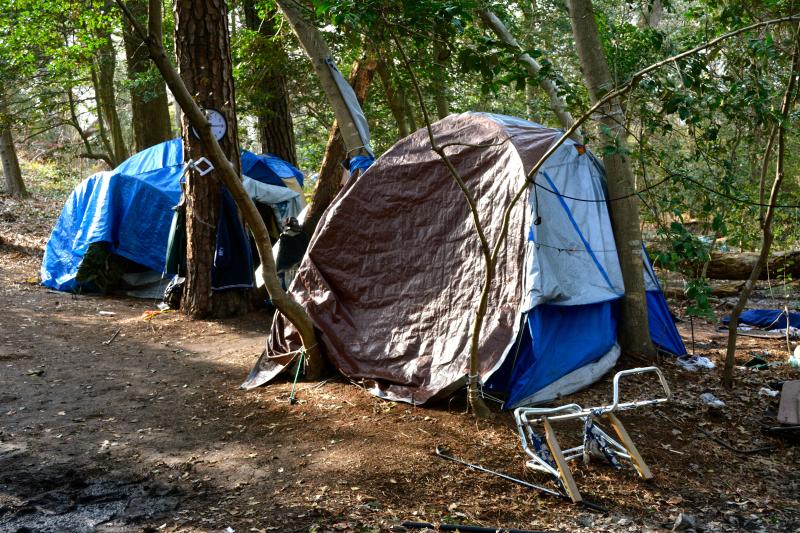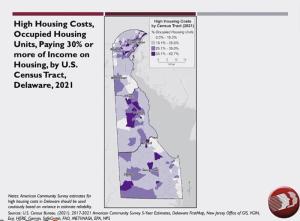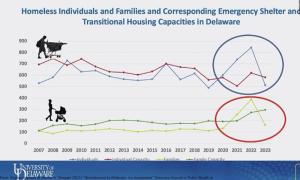Many homeless uncounted, advocates say
Affordable housing advocates gathered at Legislative Hall Dec. 6 to say there are more people experiencing homelessness than statistics show.
Speaking at a joint Senate Housing and Land Use Committee and the House Housing Committee hearing, the Division of Public Health’s Sequoia Rent, chief of the Bureau of Health Equity, presented a recent housing assessment that administered 531 surveys across the state, including 168 that were done in Sussex County.
Rent said a house is considered crowded if it has about one person per room, and using that metric, the report states, Sussex County had the largest percentage of crowded housing at 18.5%.
According to the report, 28 Sussex County respondents were worried about losing their home, which at 16.4% was the top state percentage. A map of Delaware showed the largest area of vulnerable neighborhoods lies in the mid and western sections of Sussex County.
A 2021 U.S. Census Tract for Delaware states the highest housing costs – people paying 30% or more of their income on housing – are in Kent County, specifically an area around Dover. In Sussex County, there are pockets near Seaford, Georgetown and Milton, not the high-cost coastal area, according to the report.
The report says about 10% of Sussex County respondents had bug infestation in their homes, and about 5% had mold, inadequate AC, water leaks or smoke detectors not working.
Rep. Stell Parker Selby, D-Milton, said she was concerned about the low numbers of people surveyed, believing renters are fearful about airing their concerns.
“I know for sure there are many who are fearing landlords,” she said. “I was recently called through a third party because the person involved in an apartment is concerned they would be evicted if they told about the mold.”
Parker Selby said she hopes more people will be surveyed. Rent said they will continue to gather information on housing.
Dr. Stephen Metraux of the University of Delaware said there are about 1,100 homeless each year with some fluctuations. On paper, he said, the number of beds in shelters has generally been sufficient to accommodate homeless individuals and families.
COVID upended the numbers, but a chart he displayed showed accommodations were sufficient in 2023.
“Because of public health reasons [during COVID], shelters couldn’t take in the numbers of people that they did before, and some of them closed down,” he said.
However, he said, during that time, federal money helped pay for rooms in hotels and motels.
Still, Metraux said, there are a number of unsheltered people who have not been counted in the statistics. Those have increased by about 100 people since 2018, and homeless encampments throughout the area need to be included in the statistics.
“You're never going to shelter everybody,” he said, but he seemed convinced that there are people who would be willing to go into a shelter. “There is far greater demand for shelter among people who are homeless than there are available beds.”
Rachel Stucker, director of the Housing Alliance Delaware, said her group provides assistance to people experiencing homelessness and served more than 9,300 households from July 2022 to June 2023. Those numbers are increasing by about 400 a month, she said. For October, Stucker said, about 1,450 households contacted the alliance, and the group received about 3,400 calls from people asking about housing.
“The resources aren’t available to meet their needs every day,” she said.
Stucker said there are 1,300 people homeless each night in Delaware, which could mean people sleeping outside, in a car, in a hotel or motel, or in a shelter. One in four is under 18, and 60% who are homeless are Black, she said.
High rent is a significant factor in homelessness, and affordable housing should be available to everyone, Stucker said.
“Places where rents increased saw homeless levels increase. Places where rents remained high had high levels of homelessness,” she said.
Stucker said the state needs to establish a Housing Trust Fund, and property owners should be required to consider voucher holders when there are open units.
Speaking after the meeting, Sen. Russ Huxtable, D-Lewes, said legislators earmarked more money for affordable housing than ever last legislative session, but there is a lag time between when the funds are allocated and when units will be completed.
“We need to get developers to engage, but it may take a couple of years,” he said.
In the meantime, Huxtable said short-term solutions to house the homeless are needed.
According to the Delaware State Housing Authority, the average rent in Delaware is $1,465; in Sussex County, it is $1,387.
Caitlin Del Collo, chief strategy advisor at DSHA, said the group gave 1,226 housing vouchers and helped about 1,000 families purchase a home in 2022. She said the current housing supply is becoming increasingly unaffordable for renters aspiring to homeownership. In 2021, she said, 58% of homes in the state were single-family detached homes, and more affordable housing options are needed.
“Housing type matters because we know from this study that diverse housing types, i.e., those that are not single-family detached, can promote greater affordability and present a lower risk of cost burden when compared to a single-family home,” Del Collo said.
Responding to a question by Huxtable on how many mobile homes are available in the housing market, Del Collo said there were 10% in 2010, which dropped to 7% in 2021.
In order to afford a single-wide today, she said, a family would need to have an income of $75,000 to not be cost burdened. “That unfortunately eliminates a lot of families,” she said.
Del Collo also said interest rates have affected the ability of some families to afford to buy a home.
DSHA offers incentives and programs that provide low-cost housing for people in lower-income brackets, some of which require home ownership and do not allow the units to become rentals.
Parker Selby said she has been involved in finding affordable housing options since 1993, and the Milton area that she represents continues to be developed with few solutions.
“Are we going to keep having meetings or are we going to start acting?” she said. “I am a proactive thinker, and I like to see action. This business of affordable housing has got to be addressed.”
She said officials need to leave the meeting and make some decisions at the county level to fix the problem. Huxtable agreed: “Local jurisdictions need tools to help handle housing needs.”
Melissa Steele is a staff writer covering the state Legislature, government and police. Her newspaper career spans more than 30 years and includes working for the Delaware State News, Burlington County Times, The News Journal, Dover Post and Milford Beacon before coming to the Cape Gazette in 2012. Her work has received numerous awards, most notably a Pulitzer Prize-adjudicated investigative piece, and a runner-up for the MDDC James S. Keat Freedom of Information Award.


























































